Effect of Post-Weld Heat Treatment on the Fatigue Behavior of Medium-Strength Carbon Steel Weldments
Abstract
:1. Introduction
2. Materials and Methods
2.1. Effect of PWHT on Mechanical Properties
2.2. Effect of PWHT on Fatigue Behavior
2.2.1. Hardness Measurement
2.2.2. Specimen Tensile Test
2.2.3. Specimen Fatigue Test
2.3. Fatigue Test of Members
3. Results and Discussion
3.1. Effect of PWHT on the Mechanical Properties
3.1.1. Tensile Test
3.1.2. Microstructure and Hardness
3.1.3. Charpy Impact Characteristics
3.2. Fatigue Characteristics of Specimens
3.2.1. Microstructure and Hardness
3.2.2. Tensile Test Results
3.2.3. Specimen Fatigue Test Results
3.2.4. Residual Stress Measurement by the Contour Method
3.2.5. Fatigue Test Results of Members
4. Conclusions
- (1)
- When the base metal, HAZ, and weld metal were annealed at 590 °C and 800 °C for 1 h, the yield and tensile strength decreased but the elongation increased. When annealed at 800 °C for 1 h, the tensile curves of the base metal, HAZ, and weld metal showed almost similar behavior. That explained the almost constant hardness values and homogenization of the materials. For specimens not heat-treated, the parent material’s yield strength, the yield strength in HAZ, and the yield strength of the weld metal were 350 MPa, 345 MPa, and 340 MPa. For specimens heat-treated at 590 °C, they were 350 MPa, 345 MPa, and 340 MPa. For specimens heat-treated at 800 °C, they were 350 MPa, 345 MPa, and 340 MPa.
- (2)
- In the base material, PWHT at 800 °C slightly increased the Charpy impact absorption energy. But PWHT at 590 °C slightly lowered the impact resistance. The shock absorption energy of the weld metal was significantly lower than that of the base metal. And it did not increase much by heat treatment. For specimens not heat-treated, the Charpy impact absorption energies at 20 °C of the parent material and weld metal were 291.5 J and 187 J. For specimens heat-treated at 590 °C, they were 276 J and 166 J. For specimens heat-treated at 800 °C, the Charpy impact absorption energy at 20 °C of the parent material was 299 J.
- (3)
- PWHT had a slight effect on the fatigue strength of the base metal and slightly improved the fatigue strength of the butt-welded specimen. In the case of a specimen ground in the toe part and not heat-treated, the compressive residual stress occurred near the surface, and the fatigue strength slightly improved. However, when heat treated, the beneficial effect of the compressive residual stress disappeared, and the local damage caused by grinding lowered the fatigue strength.
- (4)
- The fatigue limit of the full-scale beam annealed at 590 °C was 10.8% lower than that of the as-welded beam. These results show the possibility of fabricating a bogie frame that does not require PWHT. Vertical and horizontal gussets welded to as-welded beams decreased the fatigue limits by 30.9% and 56%, respectively.
Funding
Institutional Review Board Statement
Informed Consent Statement
Data Availability Statement
Conflicts of Interest
References
- Olsen, F.O. (Ed.) Hybrid Laser-Arc Welding; CRC Press: Boca Raton, FL, USA; Elsevier: Amsterdam, The Netherlands, 2009; ISBN 978-1-4398-0214-4. [Google Scholar]
- Krebs, A.; Kassner, M. Influence of welding residual stresses on fatigue design of welded joints and components. Weld. World 2007, 51, 54–68. [Google Scholar] [CrossRef]
- Farajian, M. Welding residual stress behavior under mechanical loading. Weld. World 2013, 57, 157–159. [Google Scholar] [CrossRef]
- Goo, B.C.; Lee, D.H.; Seo, J.W.; Yang, S.Y.; Kwon, S.J. Development of Remaining Life Estimation Techniques for Rolling Stock Structures; KRRI Research Report 04–99 (in Korean). Korea Railroad Research Institute: Uiwang, Korea, 2004. [Google Scholar]
- Huang, C.C.; Pan, Y.C.; Chuang, T.H. Effects of post-weld heat treatments on the residual stress and mechanical properties of electron beam welded SAE 4130 steel plates. J. Mater. Eng. Perform. 1997, 6, 61–68. [Google Scholar] [CrossRef]
- Wang, D.; Zhang, H.; Gong, B.; Deng, C. Residual stress effects on fatigue behaviour of welded T-joint: A finite fracture mechanics approach. Mater. Des. 2016, 91, 211–217. [Google Scholar] [CrossRef]
- Liljedahl, C.D.M.; Brouard, J.; Zanellato, O.; Lin, J.; Tan, M.L.; Ganguly, S.; Irving, P.E.; Fitzpatrick, M.E.; Zhang, X.; Edwards, L. Weld residual stress effects on fatigue crack growth behaviour of aluminium alloy 2024-T351. Int. J. Fatigue 2009, 31, 1081–1088. [Google Scholar] [CrossRef]
- Kang, G.; Luo, H. Review on fatigue life prediction models of welded joint. Acta Mech. Sin. 2020, 36, 701–726. [Google Scholar] [CrossRef]
- Wang, X.; Meng, Q.; Hu, W. Fatigue life prediction for butt-welded joints considering weld-induced residual stresses and initial damage, relaxation of residual stress, and elasto-plastic fatigue damage. Fatigue Fract. Eng. Mater. Struct. 2019, 42, 1373–1386. [Google Scholar] [CrossRef]
- Baumgartner, J.; Bruder, T. Influence of weld geometry and residual stresses on the fatigue strength of longitudinal stiffeners. Weld. World 2013, 57, 841–855. [Google Scholar] [CrossRef]
- McClung, R.C. A literature survey on the stability and significance of residual stresses during fatigue. Fatigue Fract. Eng. Mater. Struct. 2007, 30, 173–205. [Google Scholar] [CrossRef]
- Aoki, S.; Nishimura, T.; Hiroi, T. Reduction method for residual stress of welded joint using random vibration. Nucl. Eng. Des. 2005, 14, 1441–1445. [Google Scholar] [CrossRef]
- Munsi, A.S.M.Y.; Waddell, A.J.; Walker, C.A. Modification of residual stress by post-weld vibration. Mater. Sci. Technol. 2001, 17, 601–605. [Google Scholar] [CrossRef]
- Zhang, Q.; Yu, L.; Shang, X.; Zhao, S. Residual stress relief of welded aluminum alloy plate using ultrasonic vibration. Ultrasonics 2020, 107, 106164. [Google Scholar] [CrossRef] [PubMed]
- Mordfin, L. (Ed.) Mechanical Relaxation of Residual Stress; ASTM International: West Conshohocken, PA, USA, 1988. [Google Scholar] [CrossRef]
- Takanashi, M.; Iida, K. Relaxation of welding residual stresses by reversed and repeated loadings. Jpn. Weld. Soc. 2001, 19, 129–139. [Google Scholar] [CrossRef]
- Leitner, M.; Mössler, W.; Putz, A.; Stoschka, M. Effect of post-weld heat treatment on the fatigue strength of HFMI-treated mild steel joints. Weld. World 2015, 59, 861–873. [Google Scholar] [CrossRef]
- Goo, B.C.; Lee, C.W.; Seo, J.W.; Kwon, S.J. Effect of postweld heat treatment on microstructure and fatigue strength of SM490A welded plates. J. Korean Soc. Railw. 2020, 20, 448–455. [Google Scholar] [CrossRef]
- Udo, R.; Numakura, H. Effect of post-weld heat treatment on fatigue reliability of super-duplex-stainless-steel weldments. ISIJ Int. 2017, 57, 1228–1232. [Google Scholar] [CrossRef] [Green Version]
- Zhang, C.; Ren, C.; Lei, B.; Hu, X.; Lu, P. Effect of post-weld heat treatment on the fatigue and fracture mechanisms of weld-repaired bisplate 80 with or without a buffer layer. JMEPEG 2017, 26, 2742–2753. [Google Scholar] [CrossRef]
- Kalyankar, D.; Chudasama, G. Effect of post weld heat treatment on mechanical properties of pressure vessel steels. Mater. Today Proc. 2018, 5, 24675–24684. [Google Scholar] [CrossRef]
- Tomków, J.; Janeczek, A. Additional stitches for improving the weldability of steel. Appl. Sci. 2020, 10, 1823. [Google Scholar] [CrossRef] [Green Version]
- Trufyakov, V.I.; Mikheev, P.P.; Kudryavtsev, Y.F.; Reznik, D.N. Fatigue endurance of welded joints, residual stresses and fatigue improvement treatments. In Ship Structure Symposium’93. Arlington, Virginia, USA. November 16; The Society of Naval Architects and Marine Engineers and the Ship Structure Committee: Washington, DC, USA, 1993; Available online: www.shipstructure.org/pdf/93symp13.pdf (accessed on 19 October 2021).
- Galtier, A.; Statnikov, E.S. The influence of ultrasonic impact treatment on fatigue behaviour of welded joints in high-strength steel. Weld. World 2004, 48, 61–66. [Google Scholar] [CrossRef]
- Stanikov, E.S.; Muktepavel, V.O.; Blomqvis, A. Comparison of ultrasonic impact treatment (UIT) and other fatigue life improvement methods. Weld. World 2002, 46, 20–32. [Google Scholar] [CrossRef]
- International Union of Railways. Technical Specification for the Quality Control of Welded Joints on Steel Rolling Stock, 3rd ed.; UIC 897-13; International Union of Railways: Paris, France, 1993. [Google Scholar]
- The European Committee for Standardization. Railway Applications—Welding of Railway Vehicles and Components—Part 3: Design Requirements; BS EN 15085-3; European Standards s.r.o.: Pilsen, Czech Republic, 2007. [Google Scholar]
- Chen, J.; Duan, L.; Liu, S.; Zhang, M.; Zhai, P.; Yu, L. Research on the Welding Bogie Process without Heat Treatment. Available online: http://www.360doc.com/content/17/1218/19/28704984_714291266.shtml (accessed on 8 July 2021).
- Jiang, J.; Zhang, J.; Liu, J.; Chiew, S.P.; Lee, C.K. Effect of welding and heat treatment on strength of high-strength steel columns. J. Constr. Steel Res. 2018, 151, 238–252. [Google Scholar] [CrossRef]
- Lojen, G.; Vuherer, T. Optimization of PWHT of simulated HAZ subzones in P91 Steel with respect to hardness and impact toughness. Metals 2020, 10, 1215. [Google Scholar] [CrossRef]
- Silva, F.J.G.; Pinho, A.P.; Pereira, A.B. Evaluation of welded joints in P91 steel under different heat-treatment conditions. Metals 2020, 10, 99. [Google Scholar] [CrossRef] [Green Version]
- Pandey, C.; Mahapatra, M.M.; Kumar, P.; Daniel, F.; Adhithan, B. Softening mechanism of P91 steel weldments using heat treatments. Arch. Civil Mech. Eng. 2019, 19, 297–310. [Google Scholar] [CrossRef]
- Pandey, C.; Mahapatra, M.M.; Kumar, P.; Kumar, S.; Sirohi, S. Effect of post weld heat treatments on microstructure evolution and type IV cracking behavior of the P91 steel welds joint. J. Mater. Process. Technol. 2019, 266, 140–154. [Google Scholar] [CrossRef]
- Vöhringer, O. Relaxation of Residual Stresses by Annealing or Mechanical Treatment, Advances in Surface Treatments: Technology, Applications, Effects; Niku-Lari, A., Ed.; Pergamon Press: Oxford, UK, 1987; Volume 4. [Google Scholar]
- Hutanu, R.; Clapham, L.; Rogge, R.B. Intergranular strain and texture in steel Lüders bands. Acta Mater. 2005, 53, 3517–3524. [Google Scholar] [CrossRef]
- Prime, M.B. Cross-Sectional mapping of residual stresses by measuring the surface contour after a cut. J. Eng. Mater. Technol. 2001, 123, 162–168. [Google Scholar] [CrossRef] [Green Version]
- Prime, M.B.; Kastengren, A.L. The contour method cutting assumption: Error minimization and correction. Exp. Appl. Mech. 2011, 6, 233–250. [Google Scholar]
- Mahmoudi, A.H.; Hosseinzadeh, F.; Jooya, M. Plasticity effect on residual stresses measurement using the contour method. Int. J. Eng. 2013, 26, 1203–1212. [Google Scholar] [CrossRef] [Green Version]
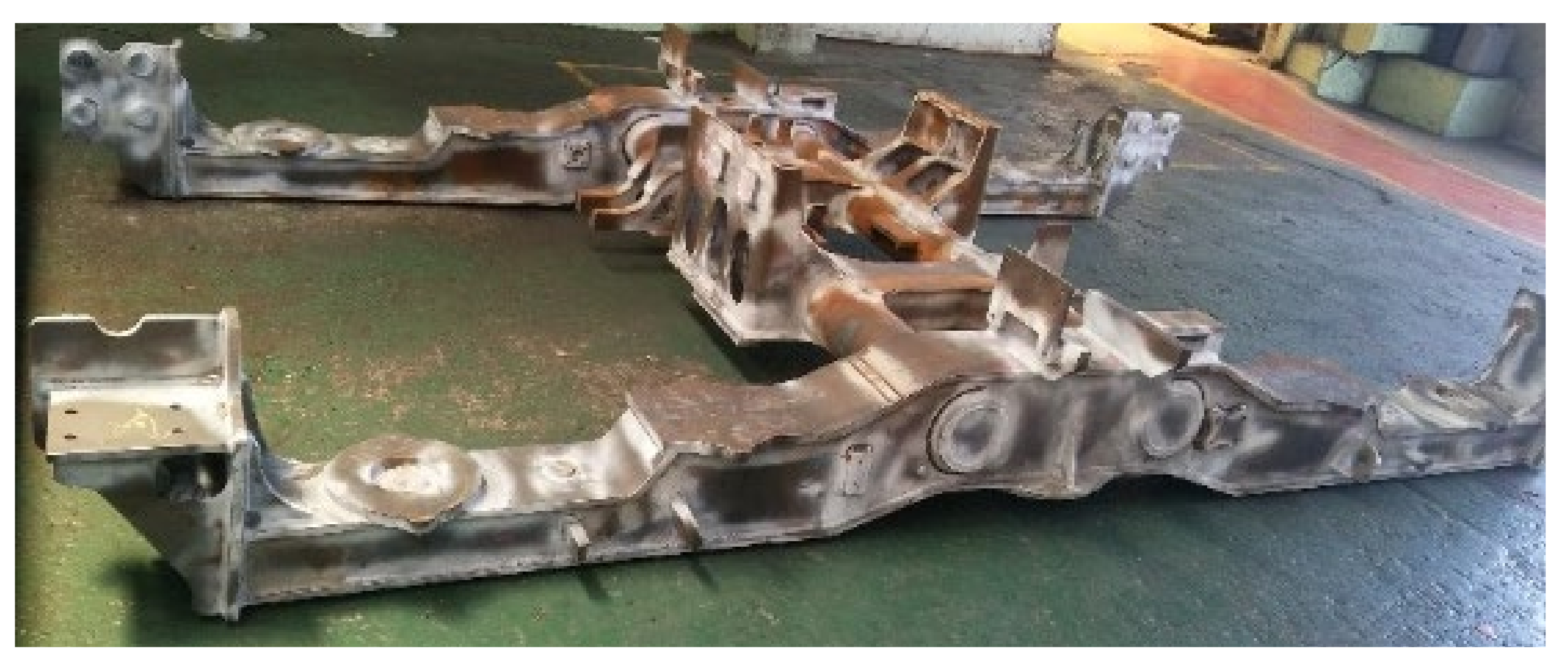


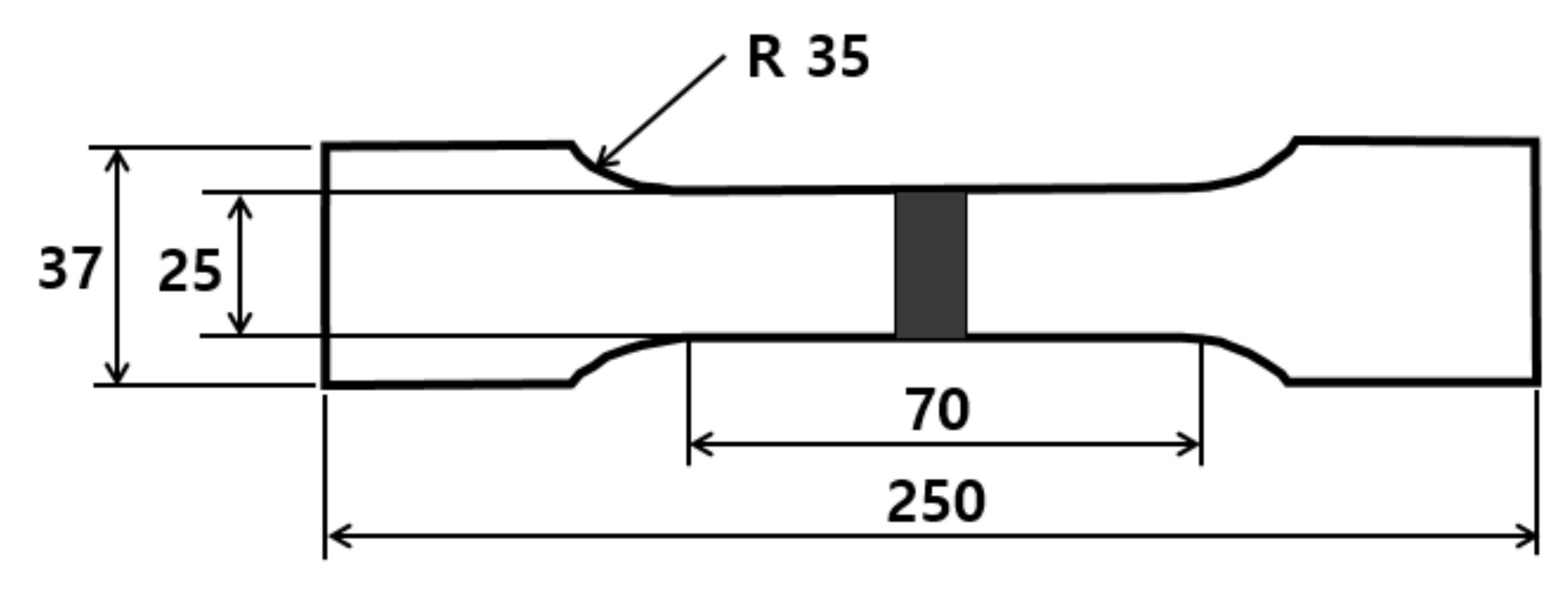
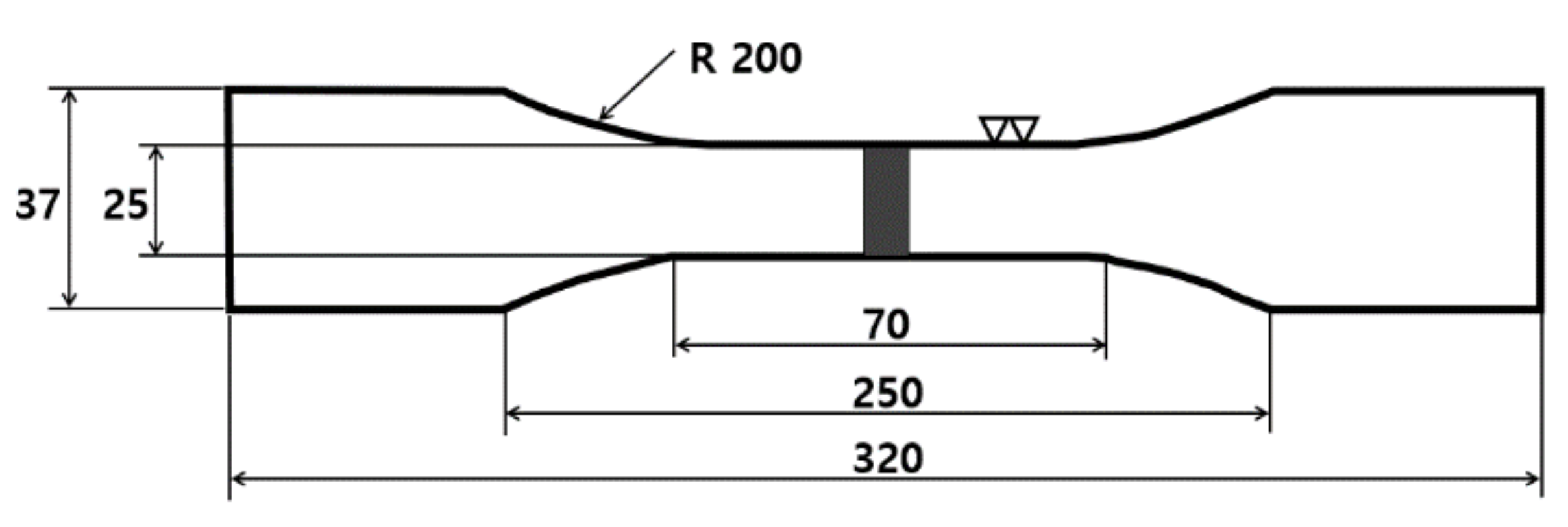





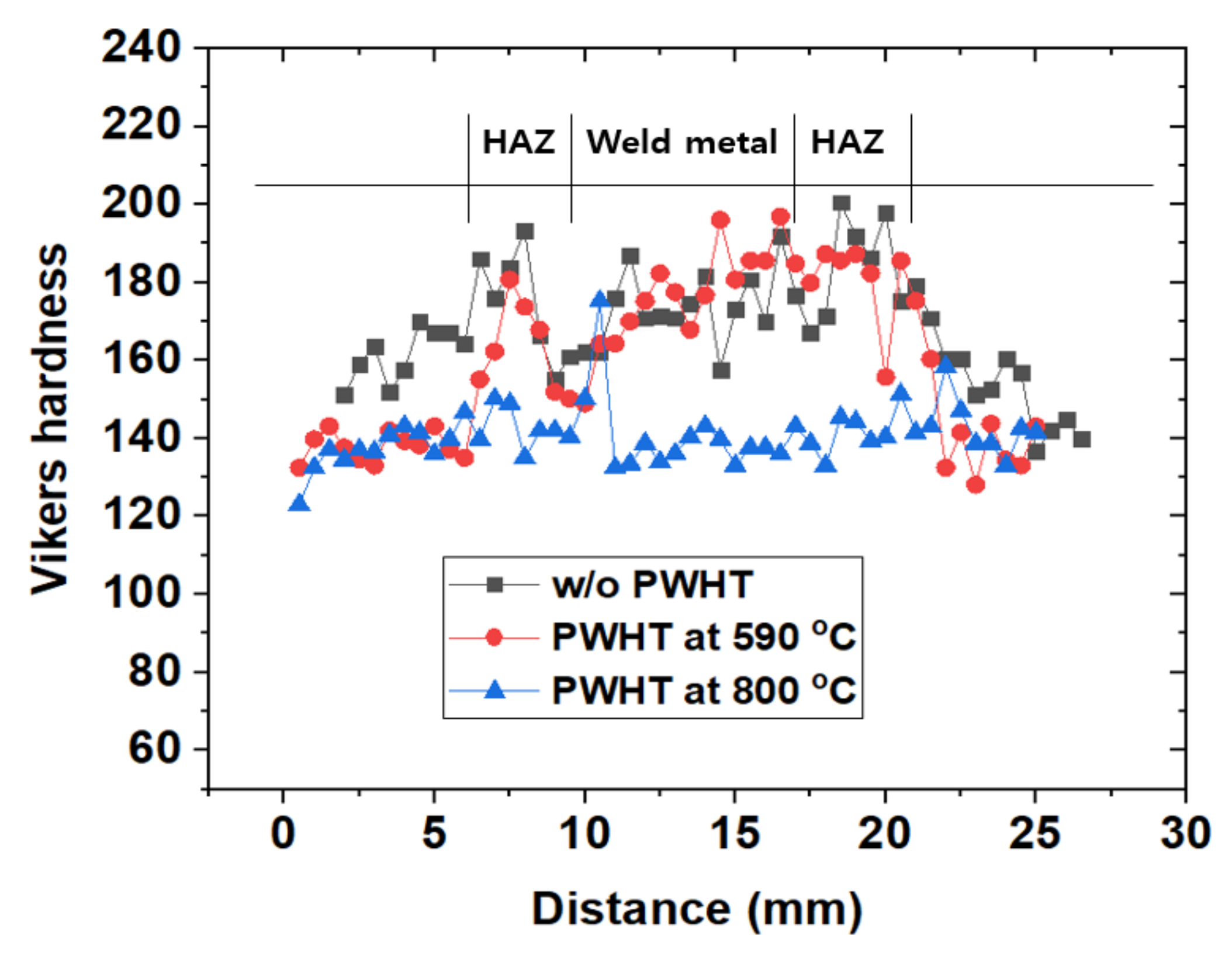
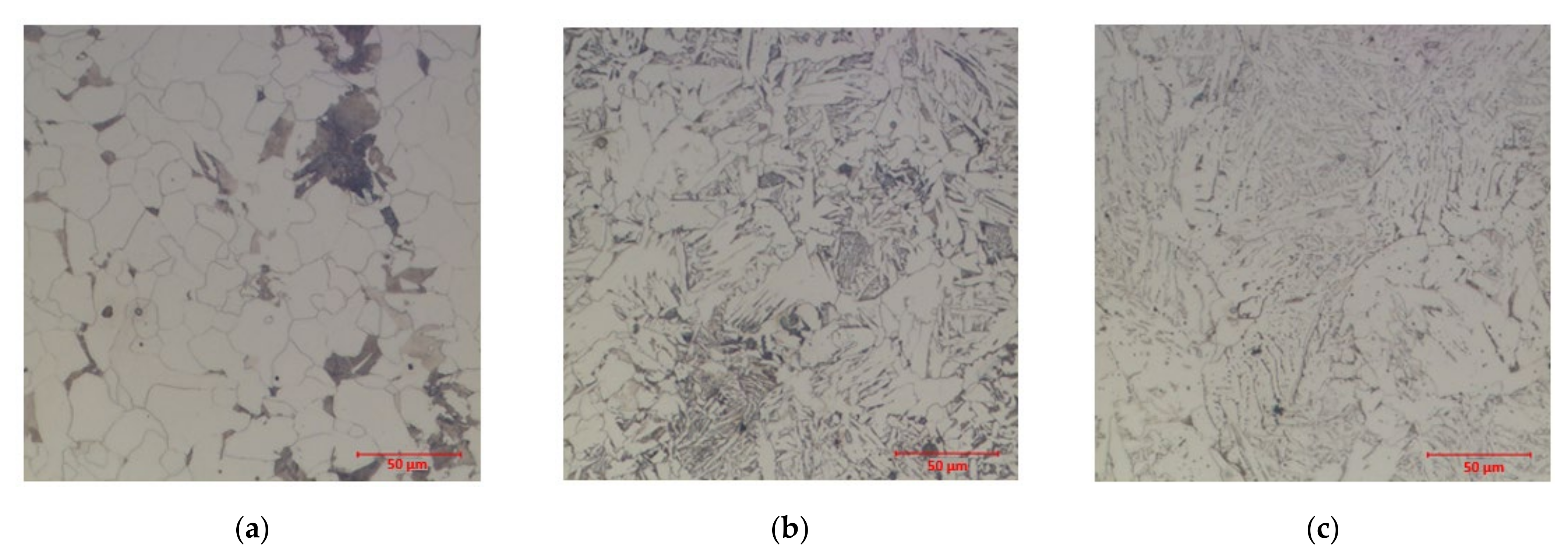


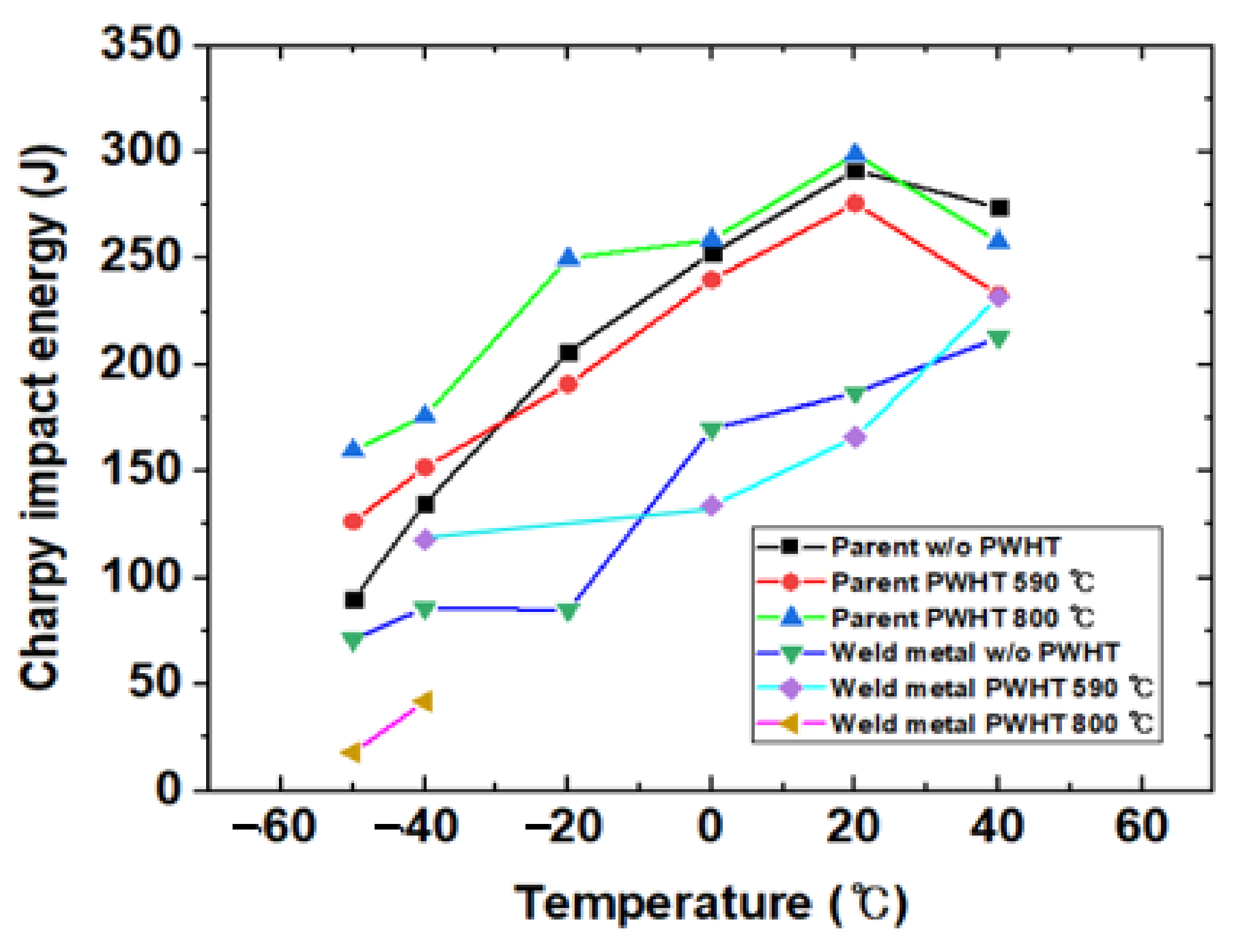







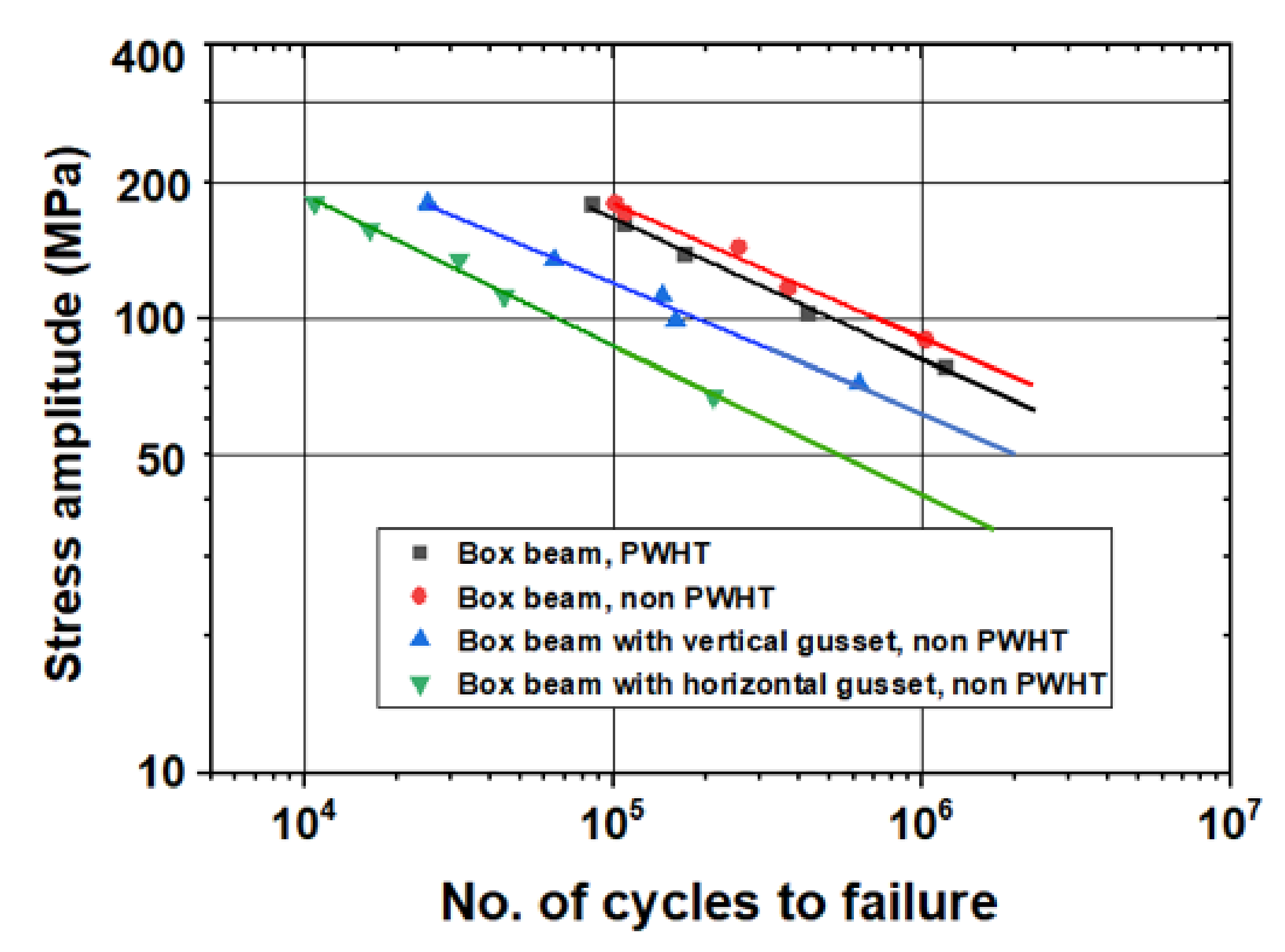

| Item | Parent Material as Welded | Parent Material Heat Treated at 590 °C | Parent Material Heat Treated at 800 °C | ||||||
|---|---|---|---|---|---|---|---|---|---|
| Specimen | No. 1 | No. 2 | No. 3 | No. 1 | No. 2 | No. 3 | No. 1 | No. 2 | No. 3 |
| (MPa) | 364 | 363 | 366 | 356 | 355 | 354 | 310 | 323 | 322 |
| (MPa) | 522 | 524 | 524 | 509 | 506 | 511 | 475 | 479 | 482 |
| (%) | 24.0 | 23.9 | 23.4 | 26.8 | 24.3 | 28.7 | 26.2 | 26.6 | 25.2 |
| Item | HAZ as Welded | HAZ Heat Treated at 590 °C | HAZ Heat Treated at 800 °C | ||||||
|---|---|---|---|---|---|---|---|---|---|
| Specimen | No. 1 | No. 2 | No. 3 | No. 1 | No. 2 | No. 3 | No. 1 | No. 2 | No. 3 |
| (MPa) | 366 | 366 | 359 | 327 | 335 | 332 | 310 | 314 | 305 |
| (MPa) | 529 | 521 | 522 | 506 | 511 | 510 | 478 | 480 | 478 |
| (%) | 25.1 | 16.8 | 13.3 | 24.8 | 24.8 | 26.3 | 19.8 | 24.8 | 19.9 |
| Item | Weld Metal as Welded | Weld Metal Heat Treated at 590 °C | Weld Metal Heat Treated at 800 °C | ||||||
|---|---|---|---|---|---|---|---|---|---|
| Specimen | No. 1 | No. 2 | No. 3 | No. 1 | No. 2 | No. 3 | No. 1 | No. 2 | No. 3 |
| (MPa) | 442 | 449 | 448 | 385 | 413 | 393 | 327 | 329 | 327 |
| (MPa) | 549 | 557 | 568 | 520 | 549 | 535 | 483 | 486 | 481 |
| (%) | 13.1 | 11.3 | 19.0 | 15.9 | 21.3 | 21.9 | 28.9 | 26.4 | 19.7 |
| Hardness Value (Hv) | Parent Material | HAZ | Weld Metal |
|---|---|---|---|
| As-welded | 170.0 | 193.3 | 192.0 |
| Heat treated at 590 °C | 143.1 | 180.7 | 196.9 |
| Heat treated at 800 °C | 139.8 | 150.1 | 175.2 |
| Specimen | a | b | Fatigue Strength at 2 × 106 Cycles (MPa) | R2 (Coefficient of Determination) |
|---|---|---|---|---|
| BMN | −0.10848 | 2.83143 | 140.5 | 0.99 |
| BMY | −0.0940 | 2.74645 | 142.6 | 0.91 |
| AAN | −0.23124 | 3.35092 | 78.3 | 0.91 |
| AAY | −0.1734 | 3.04473 | 89.5 | 0.97 |
| GAN | −0.22232 | 3.31668 | 82.3 | 0.89 |
| GAY | −0.21682 | 3.26416 | 79.1 | 0.88 |
| Specimen | a | b | Fatigue Strength at 2 × 106 Cycles (MPa) | R2 (Coefficient of Determination) |
|---|---|---|---|---|
| Box beam, non PWHT | 0.29716 | 3.74015 | 73.7 | 0.98 |
| Box beam, PWHT | 0.31092 | 3.77661 | 65.7 | 0.99 |
| Box beam V, non PWHT | 0.28614 | 3.50966 | 50.9 | 0.98 |
| Box beam H, non PWHT | 0.33162 | 3.59949 | 32.4 | 0.99 |
Publisher’s Note: MDPI stays neutral with regard to jurisdictional claims in published maps and institutional affiliations. |
© 2021 by the author. Licensee MDPI, Basel, Switzerland. This article is an open access article distributed under the terms and conditions of the Creative Commons Attribution (CC BY) license (https://creativecommons.org/licenses/by/4.0/).
Share and Cite
Goo, B.-C. Effect of Post-Weld Heat Treatment on the Fatigue Behavior of Medium-Strength Carbon Steel Weldments. Metals 2021, 11, 1700. https://doi.org/10.3390/met11111700
Goo B-C. Effect of Post-Weld Heat Treatment on the Fatigue Behavior of Medium-Strength Carbon Steel Weldments. Metals. 2021; 11(11):1700. https://doi.org/10.3390/met11111700
Chicago/Turabian StyleGoo, Byeong-Choon. 2021. "Effect of Post-Weld Heat Treatment on the Fatigue Behavior of Medium-Strength Carbon Steel Weldments" Metals 11, no. 11: 1700. https://doi.org/10.3390/met11111700






